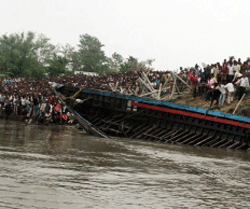Patna, Feb 21: The country is paying the price for failure to send Muslims to Pakistan and bring Hindus to India after the Islamic state came into being at the time of Independence, Union minister Giriraj Singh has said, triggering a fresh controversy.
The BJP leader made the remark in Purnea district in the Seemanchal region of Bihar which has a sizeable Muslim population and where the Begusarai MP was canvassing in favor of the Citizenship (Amendment) Act.
Highlighting the need for such a legislation, he told reporters late Thursday "when our forefathers were fighting for Independence from British rule, Jinnah was pushing for the creation of an Islamic state".
"Our forefathers, however, committed a mistake. Had they ensured that all our Muslim brothers were sent to Pakistan and Hindus brought here, the need for such a move (CAA) would not have arisen. This did not happen and we have paid a heavy price for it," the outspoken BJP leader said.
The CAA, which seeks to fast-track granting citizenship to non-Muslim refugees from Pakistan, Bangladesh and Afghanistan who might have fled their home countries because of religious persecution, has become a major bone of contention since it is feared that a country-wide National Register for Citizens (NRC) may follow.
The Narendra Modi government, which had formerly hinted that a country-wide NRC was on the anvil, seems to have put it on the backburner though a section of citizens across the country, especially Muslims, have been organizing protests out of fear that, if implemented, the NRC may result in a large number of people becoming stateless.
Singh has often been in the crosshairs of the opposition for placing his foot in the mouth. This time, however, his words were frowned upon even by NDA ally Lok Janshakti Party, founded by his cabinet colleague Ram Vilas Paswan and now headed by his son Chirag Paswan.
The young LJP chief, who kicked off a state-wide "Bihar First-Bihari First" yatra here Friday morning, to project the NDAs progressive face ahead of the assembly polls due later this year, expressed strong disapproval of Singh's utterance and noted the coalition had to suffer in the Delhi polls because of "divisive" remarks by BJP leaders.
"We are an NDA constituent but many times our coalition partners say things which the LJP does not at all agree with. This one (Giriraj Singhs statement) is such an example. Had a person of my party spoken in this fashion, I would have taken responsibility and acted," Paswan said.
He said he had placed his view repeatedly on record that the coalition had to suffer on account of divisive remarks, Paswan said in apparent reference to inflammatory speeches by BJP leaders like Union minister Anurag Thakur and BJP MP Parvesh Verma, among others.
"The people of Delhi voted on the basis of performance. We wish they do so again in Bihar and real issues don't get drowned in political cacophony.
"The Nitish Kumar government has accomplished a lot, though much more needs to be achieved. We wish to reach out to people with our vision for the future, said Paswan, before he embarked on the yatra on a customized bus decorated like a chariot in front of which he offered prayers and smashed a coconut.
Meanwhile, Giriraj Singh who loves to wear his Hindu nationalism on the sleeves was busy joining issue with Asaduddin Owaisi's AIMIM which has been under attack for controversial remarks by its leader Waris Pathan.
Sharing video of an old speech by Owaisis brother Akbaruddin which had landed him in jail, besides Pathan's recent remark, Singh asked the opposition RJD-Congress combine in Bihar and the "tukde tukde gang" whether they wanted to "convert India into Pakistan".






Comments
Add new comment